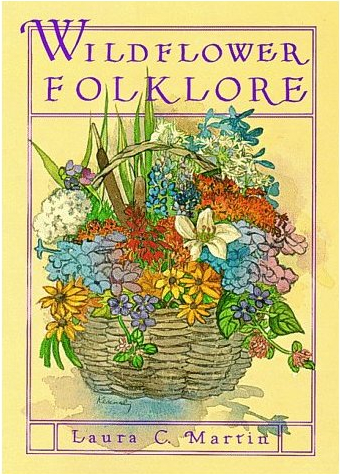 Wildflower Folklore by Laura C. Martin is a book I recently found at a library book sale. It has extensive information about many plants that Southerners have been familiar with for generations.
Wildflower Folklore by Laura C. Martin is a book I recently found at a library book sale. It has extensive information about many plants that Southerners have been familiar with for generations.
For instance, kudzu was first introduced to the United States through the Japanese Pavilion during the Philadelphia Centennial Exposition in 1876. The Japanese used kudzu for food, medicine, and as a forage plant. Their intensive land-use practices kept it under control in their country, but we Southerners let it get out of control.
Kudzu was first thought to be a wonder cure for eroded areas here in the South because it would grow quickly even in our red clay. At first, it was grown commercially as a forage plant and was hailed as “King Kudzu.” When it began to “eat” telephone poles and trees, people became more than disenchanted with it and began calling it the “plant that ate the South.” Since it can grow 80 to 100 feet during one growing season, kudzu can be controlled by grazing goats but the highway department has yet to discover this fact.

Kudzu, or Pueraria lobata, is no longer grown commercially in this country because it is too easy to overgraze and it is difficult to harvest mechanically. Although its vines can be used to make wreaths, its products are not as attractive as those made from wild grape vines.
Alas, the kudzu is not just the butt of jokes and is no longer considered a wild plant you want to see creep into your yard!

Ginseng (or Panax quinquefolium) on the other hand, is a plant that is highly prized today. Called by the Chinese “a dose of immortality,” the Cherokees’ name for it meant the “plant of life.” It is valued highly for its medicinal use and has all types of magical powers attributed to it.
In William Byrd’s Histories of the Dividing Line Betwixt Virginia and North Carolina, he advises that ginseng can give warmth and vigor to the blood, can cheer up even a man who has a bad wife, and can help a man live longer and very well.
The root of the ginseng is what is prized and is “trouser-shaped.” The word “ginseng” is a corruption of the Chinese word “jin-chen” that means “manlike” or “trouser-shaped.” The Iroquois Indians called it “child” and the Greeks gave it a name that means “cure all.”
The Chinese use ginseng as a heart stimulant and prize it as an aphrodisiac. It was considered only for the nobility because of its worth and its expense; at one time, only the Emperor was allowed to collect it.
American Natives used ginseng to treat headaches, fevers and coughs. It is now used as a general tonic, to help the body handle stress, and to regulate hormonal flow because it has been found to be beneficial to endocrine glands.
Collecting ginseng from the wild is regulated in many states because it is considered rare or threatened. In most states, it is illegal to harvest wild ginseng that is less than five years old and it must have a certain number of roots. It is essential to learn about state laws before searching out ginseng for harvest. Since cultivated roots do not seem to have the “magic” of wild ginseng, American exporters will not buy cultivated ginseng for exporting to Hong Kong where most ginseng is purchased.
Whether wild plants become trash or treasure is determined by the way human beings handle their growth. Kudzu and ginseng are only two of the wild plants found in the South. Learning about them can lead you to others that are just as interesting; in fact, wild plants can become a fascinating education in themselves—and a hobby for a lifetime.
Just remember that it’s better to photograph wild plants than to believe that digging them is an option; most wild plants are happy just where they are and will only die if you try to transplant them.
Look but don’t touch.


